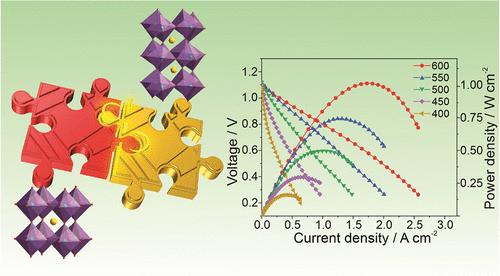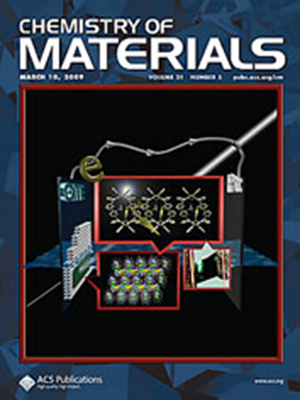Engineering of a Coupled Nanocomposite as a High-Performance Protonic Ceramic Fuel Cell Cathode
IF 7.2
2区 材料科学
Q2 CHEMISTRY, PHYSICAL
引用次数: 0
Abstract
The lack of high-performance cathode catalysts is a salient issue that bedeviled the commercialization of protonic ceramic fuel cells (PCFCs). Here, we report a remarkable electrocatalytic activity and stability enhancement of cathode electrodes by engineering a coupled nanocomposite. The as-prepared Pr0.3(Ba0.5Sr0.5)0.7Co0.8Fe0.2O3−δ nanocomposite possesses a bulk cubic phase on which homogeneous and intimate orthorhombic PrCo0.5Fe0.5O3−δ nanoparticles are uniformly decorated. X-ray diffraction and Raman spectroscopy reveal the excellent thermal stability of the nanocomposite. It achieves a high peak power density of 1.02 W cm–2 based on protonic electrolytes at 600 °C. No noticeable structural degradation is observed over ∼210 h at 550 °C according to scanning electron microscopy analysis. This work demonstrates an effective strategy to boost the performance of perovskite oxides for PCFCs via nanocomposite engineering. It may apply to other catalyst designs and discoveries, such as for batteries, electrolyzers, and membrane reactors.

将耦合纳米复合材料工程设计为高性能质子陶瓷燃料电池阴极
缺乏高性能阴极催化剂是阻碍质子陶瓷燃料电池(PCFC)商业化的一个突出问题。在此,我们报告了通过工程耦合纳米复合材料显著提高阴极电极电催化活性和稳定性的情况。制备的 Pr0.3(Ba0.5Sr0.5)0.7Co0.8Fe0.2O3-δ 纳米复合材料具有块状立方相,在立方相上均匀地装饰着均质而紧密的正方体 PrCo0.5Fe0.5O3-δ 纳米粒子。X 射线衍射和拉曼光谱显示该纳米复合材料具有优异的热稳定性。在 600 °C 的质子电解质条件下,它能达到 1.02 W cm-2 的峰值功率密度。根据扫描电子显微镜分析,在 550 °C 下经过 ∼210 小时,未观察到明显的结构退化。这项工作展示了一种有效的策略,即通过纳米复合工程提高用于 PCFC 的过氧化物的性能。它可能适用于其他催化剂的设计和发现,如电池、电解器和膜反应器。
本文章由计算机程序翻译,如有差异,请以英文原文为准。
求助全文
约1分钟内获得全文
求助全文
来源期刊

Chemistry of Materials
工程技术-材料科学:综合
CiteScore
14.10
自引率
5.80%
发文量
929
审稿时长
1.5 months
期刊介绍:
The journal Chemistry of Materials focuses on publishing original research at the intersection of materials science and chemistry. The studies published in the journal involve chemistry as a prominent component and explore topics such as the design, synthesis, characterization, processing, understanding, and application of functional or potentially functional materials. The journal covers various areas of interest, including inorganic and organic solid-state chemistry, nanomaterials, biomaterials, thin films and polymers, and composite/hybrid materials. The journal particularly seeks papers that highlight the creation or development of innovative materials with novel optical, electrical, magnetic, catalytic, or mechanical properties. It is essential that manuscripts on these topics have a primary focus on the chemistry of materials and represent a significant advancement compared to prior research. Before external reviews are sought, submitted manuscripts undergo a review process by a minimum of two editors to ensure their appropriateness for the journal and the presence of sufficient evidence of a significant advance that will be of broad interest to the materials chemistry community.
 求助内容:
求助内容: 应助结果提醒方式:
应助结果提醒方式:


